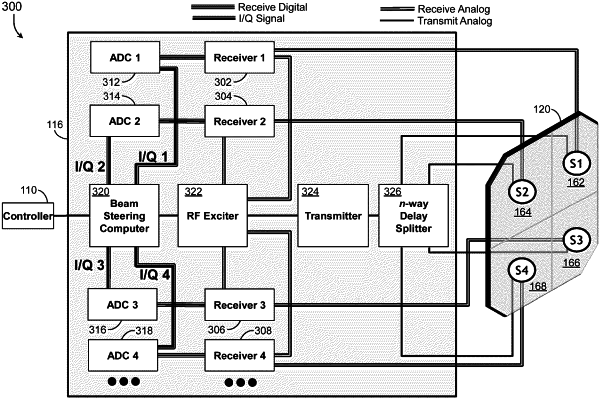| CPC G01S 7/414 (2013.01) [G01S 7/03 (2013.01); G01S 13/426 (2013.01); G01S 13/933 (2020.01); H01Q 3/385 (2013.01); G01S 2013/0254 (2013.01)] | 13 Claims |

|
1. A multi-beam multi-function radar antenna system, comprising:
a single active electronically scanned array (AESA) mounted at a fixed boresight onboard an aircraft, the single AESA configured for a segmented aperture enabling a first aperture beam having a first aperture beam characteristic, a first azimuth, and a first elevation, the segmented aperture also enabling at least one second aperture beam having a second aperture beam characteristic, a second azimuth, and a second elevation, each of the first aperture beam and the at least one second aperture beam being independently steered, coherent, and simultaneously radiated from the single AESA;
at least one aircraft system onboard the aircraft configured to 1) receive a specific radar dataset from the single AESA and 2) perform a system function based on the received specific radar dataset, the specific radar dataset provided by one of the first aperture beam and the at least one second aperture beam;
a controller operatively coupled with the single AESA and the at least one aircraft system;
a tangible, non-transitory memory configured to communicate with the controller, the tangible, non-transitory memory having instructions stored therein that, in response to execution by the controller, cause the controller to:
receive a first radar command from a first system of the at least one aircraft system and a second radar command from at least one second system of the at least one aircraft system, the first radar command includes the first aperture beam characteristic, the first azimuth, the first elevation, the second radar command includes the second aperture beam characteristic, the second azimuth, and the second elevation;
in response to the first radar command and the second radar command, segment the single AESA into at least two AESA subarrays, based on the first radar command and the second radar command, to transmit and receive the first aperture beam and the at least one second aperture beam, the first aperture beam having the first aperture beam characteristic based on the first radar command and the at least one second aperture beam having the at least one second aperture beam characteristic based on the second radar command;
transmit and steer the first aperture beam based on the first radar command and the at least one second aperture beam based on the second radar command;
receive a first radar return from the first aperture beam and at least one second radar return from the at least one second aperture beam;
digitally combine the first radar return from the first aperture beam and the at least one second radar return from the at least one second aperture beam via a digital signal processing to create a first specific radar dataset associated with the first system and a second specific radar dataset associated with the at least one second system;
supply the first system with the first specific radar dataset associated with the first system and the at least one second system with the second specific radar dataset associated with the at least one second system; and
execute the system function of the first system based on the first specific radar dataset associated with the first system and the system function of the at least one second system based on the second specific radar dataset associated with the at least one second system.
|